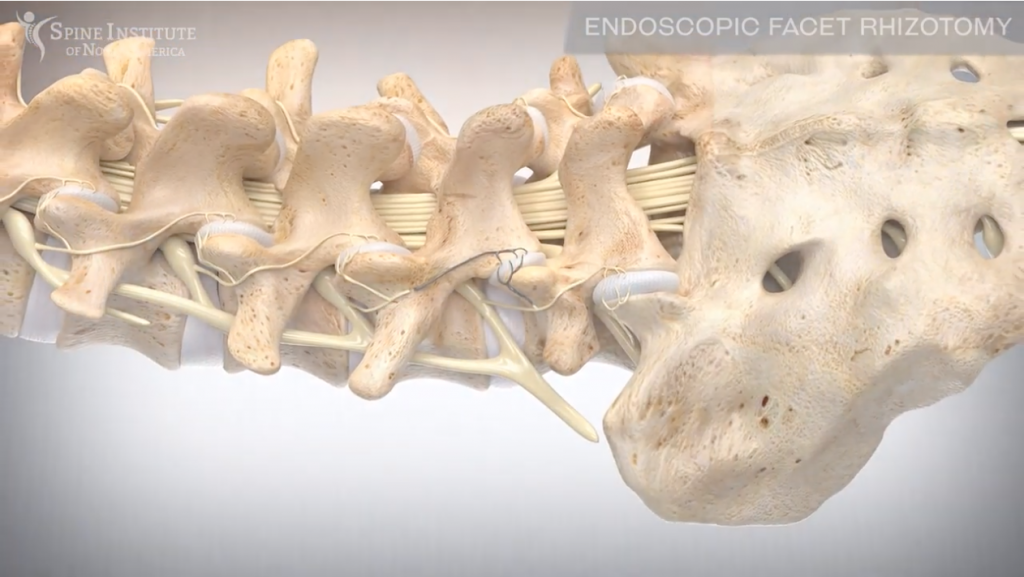Least-invasive procedures can have names that not everyone is familiar with. For example, not many people without medical training know what a rhizotomy procedure is. However, if you experience back pain, rhizotomy surgery provides relief with the least invasive methods possible. Keep reading to learn about rhizotomy and endoscopic rhizotomy procedures.
Call today
What Does “Rhizotomy” Mean?
Doctors first used the word “rhizotomy” around 1910-1915. It comes from two root words: rhizo- (root) and -tomy (incision). The “roots” that the word refers to are the roots of your spinal nerves. That means when a doctor conducts a rhizotomy, they sever the nerves’ roots. Cutting the nerve roots removes the pain sensation. When back pain becomes chronic and severe, certain patients benefit from this procedure.
Radiofrequency Ablation and Endoscopic Rhizotomy
Two common types of rhizotomy are radiofrequency ablation and endoscopic rhizotomy. Both methods have the same goal, but they achieve that goal in different ways.
During a radiofrequency ablation procedure, the doctor uses heat to disable the nerve that causes the patient’s back pain. Radiofrequency ablation is a percutaneous procedure, meaning it involves a needle. This needle transfers a microelectrode that heats the targeted nerves. To pinpoint the nerve’s location, the doctor uses a fluoroscopic X-ray. Keep in mind that some people refer to this method simply as “rhizotomy,” so you may need to ask for clarification when talking about it.
Endoscopic rhizotomy involves using a small camera to find the affected location. The camera travels directly through the nerve branch, letting the doctor see the exact area of problem nerves. Once they find the location to operate, they make a small incision on the nerve roots.
Which Method Works Better?
At Spine INA, we perform endoscopic rhizotomy procedures when radiofrequency ablation fails because it relieves pain more effectively . Consider these important differences:
- A doctor conducting an endoscopic rhizotomy can directly see the nerves instead of relying on an X-ray.
- Many patients feel relief immediately after endoscopic rhizotomy. Meanwhile, it can take a month to feel the effects of radiofrequency ablation.
- Radiofrequency ablation reduces pain for up to one year, but the benefits of an endoscopic rhizotomy can last for three to five years.
Other Benefits of Treatment at Spine INA
Our physicians have carefully researched every one of the techniques they use to ensure they are conversant with the least invasive procedures possible. They focus on endoscopic methods that have a minimal negative impact on the patient and offer multiple benefits. At Spine INA, you don’t have to go through extensive surgery to feel pain relief. Schedule an appointment with one of our pain experts today.










I have been thinking of having the Radiofrequency ablation for my cronic back pain, my Dr. tells me there is a lot of pain after this procedure that can be worse then my actual back pain , for up to 10 days after, and maybe will only last from 3 t0 6 months. I do not se any mention of this in your information ,it has made think of not doing it .
Hi Bernita! We would love to provide some more information for you. Please do fill out a contact form on our site or give us a call!
I had one done, I’m not sure which but it made my pain worse and it’s been about 3 weeks.
Hi Heidi! Please give us a call so we can learn more!
I had rhizotomy performed 3 weeks ago and the pain is much worst since.l find if l stand for short time or walk it gets worse only relief is when lying down with hot water bottle
Hey Catherine! Feel free to give us a call – we’d be happy to chat!
what type of heat do you use to use with use thru to the needle?
Hey there! Please give us a call for any procedural questions or appointment inquiries!
will this procedure be for upper right leg pain ( L-3 ) disc problem
Hey Matthew! Feel free to give us a call to discuss! In the meantime, here’s a great resource on this procedure: https://spineina.com/treatments/endoscopic-spine-procedure-overview/endoscopic-rhizotomy/